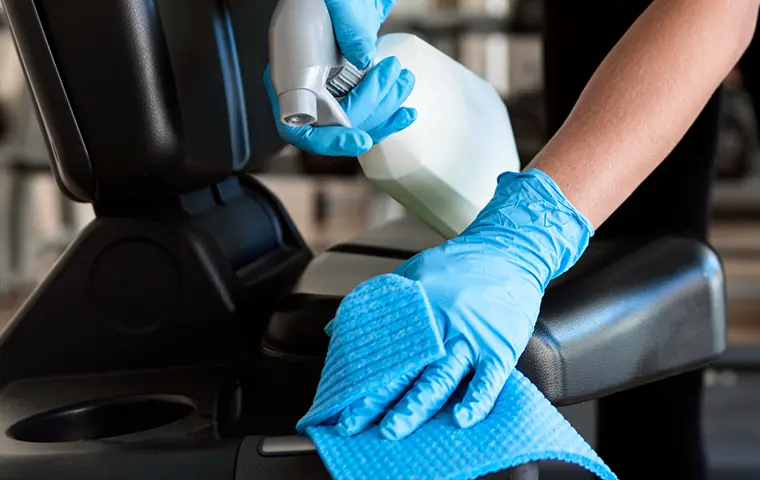How clean or not clean a vehicle is directly impacts fleet driver safety. When vehicle surfaces are not properly sanitized, germs can rapidly spread and cause drivers to become sick. Sanitization became all the more important amid COVID-19, when illness and hygiene standards increased. With its impact on driver health and well-being, it’s no surprise that vehicle sanitization strongly influences driver retention — for better or worse.
What is Vehicle Sanitization?
Vehicle sanitization is cleaning and disinfecting a vehicle, specifically high-touch surfaces like steering wheels and control panels. The goal is to ward off germs, bacteria, and viruses that can put drivers and other vehicle passengers at risk.
From a fleet driver safety standpoint, vehicle sanitization helps create a safe environment. It helps minimize the transmission of illnesses among drivers while creating a more comfortable space for drivers to work in. It also shows that a company is committed to safety and hygiene, boosting its reputation and making it easier to attract new drivers.
Vehicle Sanitization Tips
Creating a clean and safe environment for drivers is a multi-layered process. Once you’ve established a regular sanitization schedule, here are five tips for keeping your fleet vehicles clean, with suggestions for tools and products to use.
1. Gather the Right Cleaning & Sanitizing Supplies
Proper vehicle sanitization begins with preparing the right supplies. For one, you’ll want to use EPA-approved disinfectants. These products have been evaluated for safety and are proven to offer thorough, consistent sanitization. Have clean towels, disposable gloves, sanitizing wipes, and trash bags on hand.
2. Open Up Windows to Improve Air Circulation
When using disinfectants, open up the windows of a vehicle to disperse any odors. It creates a safer, more comfortable environment for folks sanitizing the vehicle and the driver who uses the vehicle next.
3. Wipe Down Vehicle Surfaces First
Focus first on those high-contact surfaces where pathogens are more prone to live. Use disinfectants to remove any visible dust or residue. It’s helpful to have a stain remover on hand in case there are any tough stains that require specialized treatment.
4. Vacuum & Clean the Vehicle Seats
Next, move on to the seats. Use a vacuum cleaner with attachments to clean hard-to-reach areas. If you notice any stains or residue on the seats, apply a cleaning solution to a clean towel and blot the area. Avoid excessive scrubbing of stains as it can damage the seat material.
5. Dispose of Any Trash in the Vehicle
Make a point to empty out any trash bins in the vehicle. Getting rid of this waste not only avoids bacteria growth; it also prevents unpleasant odors and improves air quality for drivers. You can also use this as an opportunity to clean out the trash bin and further prevent odors.
The Role of Vehicle Sanitization in Driver Retention
Fleet drivers want to work in a safe, comfortable environment. And for that to happen, they need the vehicles they operate to be regularly sanitized. When high-touch surfaces, seats, and other areas of the vehicle are clean, it helps drivers stay healthier on the job. That means less stress and fewer sick days.
When their vehicles are sanitized, fleet drivers are likely to feel more satisfied. They don’t have to worry about the hygiene of their vehicle and can instead focus on driving safely. What’s more, they feel more appreciated by their employers who have taken measures to show they value their drivers’ health.
All of these factors are an incentive for fleet drivers to stick with their current employer. For one, they’ll have a pleasant working environment that makes them feel more comfortable and accomplished. They’ll also feel more valued and respected as an employee, which lends itself to greater driver retention.
Implementing Vehicle Sanitization for Better Driver Safety
Vehicle sanitization should be part of the fleet driver safety conversation. It’s an important step for keeping drivers healthier and more comfortable on the job. The safer and more pleasant their work environment is, the better the odds are to reduce driver turnover and increase driver retention.
Questions People Also Ask
How does vehicle sanitization relate to driver retention?
Sanitizing vehicles creates a safer, more comfortable working environment for fleet drivers. Drivers feel more content and physically healthier on the job, as well as more valued by their employers. These variables help to improve driver retention.
How does vehicle sanitization contribute to driver safety?
Vehicle sanitization helps keep vehicles free of germs, bacteria, and other contaminants that can cause drivers to contract an illness. Drivers remain physically healthier and have to take fewer sick days.
What tools are required for vehicle sanitization?
Use EPA-approved disinfectants that are proven to be safe and effective. Wipe down surfaces with a microfiber cloth, and use a vacuum cleaner with attachments to clean seats. Disposable gloves are recommended during vehicle sanitization.








